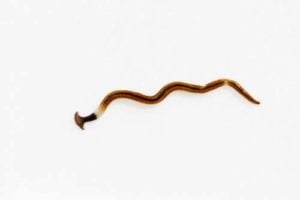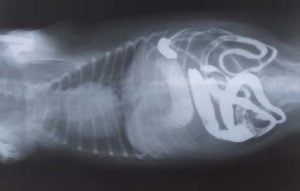
KEY TAKEAWAYS:
– Diarrhea is common in dogs, but not with blood. Consult a veterinarian immediately.
– The possible causes of bloody diarrhea in dogs include Parvovirus, parasites, Hemorrhagic Gastroenteritis, changes in diet, Inflammatory Bowel Disease, rectal injuries, etc.
– Write down the bloody diarrhea's features such as appearance, color, and smell. Take a picture or take a stool sample to your vet.
– A healthy diet, regular exercise, timely vaccination and deworming should keep your dog's gut healthy and prevent bloody diarrhea.
Table of Contents
- Bloody Diarrhea in Dogs: What Does it Look Like?
- 8 Common Causes & Treatments of Bloody Diarrhea in Dogs
- What To Do If Your Dog Has Bloody Diarrhea
- Veterinary Diagnosis of Dog Diarrhea
- How to Prevent Bloody Diarrhea in Dogs
- FAQs
- Bloody Diarrhea in Dogs: Before You Go…
Bloody diarrhea in dogs can be scary, knowing that this could be the symptom of a life-threatening condition.
But don't worry; it won't last long as long as you work with your veterinarian.
I've personally handled numerous doggy diarrhea cases with pet owners who were either prompted to act or hesitant to take their pups to the clinic.
But let me tell you: a dog's bloody diarrhea must be addressed by a veterinarian immediately.
In this article, I will discuss the common causes of bloody diarrhea in dogs, along with treatment options, prevention strategies, and immediate actions you should take as a pet owner.
Bloody Diarrhea in Dogs: What Does it Look Like?
Bloody diarrhea is a soft, runny stool that can have varying amounts of blood within it.
Sometimes, it could be just streaks; other times, it could be full-blown red blood and loose stool.
Some key signs to look for include:
- Dark, tarry stool: The blood may cause diarrhea to appear very dark, almost black. This indicates older blood.
- Bright red blood: Fresh blood will appear as vibrant red streaks or liquid mixed into the diarrhea.
- Wet, liquid stool with blood: Bloody diarrhea is usually loose and watery in consistency due to blood mixing with the gastrointestinal contents.
- Blood clots: Larger clots or globs of blood may occasionally be seen mixed in with the diarrhea.
- Black, sticky stool: Occasionally, blood degradation products will cause very black and tarry stool resembling motor oil.
- Blood on the fur around the anus: Bleeding may cause bloody staining on the skin, coat, or floor near where defecation occurred.
The 2 Types of Dog Bloody Diarrhea
Based on the stool's appearance, you can distinguish it as Hematochezia or Melena.
Hematochezia has the appearance of bright red and fresh blood in the dog's feces. This blood comes from the lower part of the digestive tract, and there are numerous potential causes.
Melena is characterized by a black and tarry appearance of the blood, accompanied by sticky feces, which occurs when the dog swallows or digests blood. It is usually the result of bleeding in the upper digestive tract and also has many possible causes.
A veterinarian should evaluate any amount of visible blood in the stool as it can indicate underlying health issues and cause for concern.
ALSO READ: The Best Dog Food for Dogs With Diarrhea and Loose Stools

8 Common Causes & Treatments of Bloody Diarrhea in Dogs
1. Parvovirus
Canine Parvovirus is a highly contagious viral infection that usually attacks the intestinal tract, but other forms of this disease can attack the heart muscle itself.
The most obvious signs of a dog suffering from parvovirus are:
- Vomiting
- Severe bloody diarrhea in dogs
- Extreme weight loss
- Lethargy
- Fever
- Hypothermia
- Noticeably red mouth and eyes
As this disease is highly infectious, your dog can pick it up either through direct contact with another infected animal.
Without any type of treatment, most infected dogs will die from the [parvovirus] disease. And even with aggressive therapy, some dogs won't make it. It can be very costly to treat them. Your best bet is prevention and keeping up with the vaccine series.
– Susan Nelson, DVM, clinical associate professor at Kansas State University
Treatments for Parvovirus in canines include:
- IV Fluids
- Antibiotics
- Injectable vitamins
- Colostrum in puppies
2. Hookworms
 These parasites clamp onto the wall of the small intestine and suck blood from their host, and are especially dangerous to young puppies and older dogs with weakened immune systems.
These parasites clamp onto the wall of the small intestine and suck blood from their host, and are especially dangerous to young puppies and older dogs with weakened immune systems.
MADR hookworms present an even greater need for veterinarians to counsel owners on parasite control, fecal hygiene measures, and required routine diagnostics
-Dr. Pablo Jimenez Castro, AAVP
Symptoms of hookworms include:
- Anemia
- Pale gums
- Lethargy
- An unhealthy coat and flaky skin
- Coughing
A dog can contract hookworms through direct skin penetration from the larvae, while puppies can get it from their mother's milk.
Treatments usually include a parasitic dewormer for dogs and iron supplements.
However, experts have found drug-resistant hookworms, prompting the American Association of Veterinary Parasitologists to establish a task force in 2021.
The AAVP Task Force encourages state veterinarians to share information about drug-resistant hookworms because of the potential widespread transmission and zoonotic risk.
3. Hemorrhagic Gastroenteritis (HGE)
This condition baffles veterinarians as little is known about what causes it.
The cause of HGE is still unclear so there is no way to prevent the condition. Small, young, purebred dogs are more prone to HGE but it can affect any size or breed.
– Dr. Katja Lang, Heart of Chelsea Animal Hospital, New York
Known to attack young small-breed dogs predominantly, this condition is caused by the body reacting adversely to food or bacteria.
It causes proteins, red blood cells, and fluids to leak through the lining of the intestinal tract, and this takes place even when no inflammation is present.
If your dog suffers from Hemorrhagic Gastroenteritis, catching it quickly will help a lot, according to case studies from other vets and research.
Keep an eye out for the following symptoms:
- Sudden vomiting
- Bloody diarrhea in dogs with a foul odor
- Depression
- Lethargy
- Weight loss
Unfortunately, all dogs can catch this condition, and well over 10% of dogs will suffer from at least one bout of this illness in their lifetime.
Common treatments include antibiotics, IV fluids, and potassium and electrolyte supplements.
4. Whipworms 
The whipworm is especially dangerous as its eggs can survive in just about any environment, from water and food to soil and bedding.
The eggs can also survive for years without a host, and extreme cases can lead to serious infection and death.
“Once in the environment, the eggs are very resistant to drying, temperature extremes, and ultraviolet radiation. They can remain viable in the environment for years. Animals are exposed when they ingest the eggs from the ground and soil or from eating the stool of an infected animal.”
– Dr. Rick Marrinson, Longwood Veterinary Clinic, Florida
Most veterinarians advise whipworm checks to take place at least once annually.
Symptoms of this parasite include:
- Dehydration
- Anemia
- Bloody diarrhea in dogs
Any age, breed, and size of dog can contract this parasite; that's why hygiene must reign supreme when trying to prevent a case of whipworm.
The best treatment is a parasitic dewormer.
5. Roundworms
 The roundworm can produce up to 85,000 eggs per day.
The roundworm can produce up to 85,000 eggs per day.
Initially, the eggs are ingested by the dogs, which will progress into larvae and make their way to the digestive tract, where they can roam freely, feeding off of partly digested matter.
When their number grows, they can cause a life-threatening blockage.
Symptoms of a roundworm infestation in your pet can include:
Most commonly, puppies are infected by their mother just before birth or while nursing.
Roundworms are tricky little devils and can live dormant in dogs for their entire lives.
Similar to other types of worms, the treatment for this parasite is a parasitic dewormer.
RELATED: Can Humans Get Worms From Dogs?
6. Changes in Diet
A change in diet can cause health issues, especially in sensitive dogs that have food intolerances or allergies.
However, issues can occur in sensitive dogs as well, or due to food intolerances and allergies, with even the most minor change.
Signs that your dog's new diet is not agreeing with him include:
- Vomiting
- Bloody diarrhea in dogs
- Flatulence
- Weight Loss
- Scratching incessantly
It's best to speak with your veterinarian about the best way to treat your dog's food intolerance issue.
Some treatment options may include:
- Revert to old food if possible
- Allergy testing
- Conduct an elimination diet
RELATED: 3 Things to Know Before Switching to Homemade Dog Food Diet
7. Inflammatory Bowel Disease (IBD)
 In essence, inflammatory bowel disease (IBD) is the irritable bowel syndrome (IBS) for dogs.
In essence, inflammatory bowel disease (IBD) is the irritable bowel syndrome (IBS) for dogs.
This condition is generally caused by the body reacting adversely to normal bacteria in the gut and instigating a defense response that causes inflammation of the bowel.
Common symptoms of Inflammatory Bowel Disease include:
- Bloody diarrhea in dogs
- Lethargy
- Flatulence
- Gurgling stomach
- Dull coat
- Weight Loss
- Vomiting
As with humans, little is known about what causes this condition, but the most likely culprit is food sensitivity and allergies.
Treatments include anti-inflammatory medication and diet modification.
Experts have also been exploring additional methods to treat IBD in dogs through the use of probiotics.
“We are studying the clinical, microbiological, and anti-inflammatory effects of this probiotic in the treatment of IBD. Current treatments for IBD include anti-inflammatory drugs, some of which have serious side effects and do not address the underlying basis for the disease, the altered microbial composition.
“Probiotics offer an attractive physiologic and nontoxic alternative that effectively protects against and treats IBD.”
– Dr. Albert E. Jergens, Primary research investigator
TRY THIS: Recipe: Homemade Dog Food for IBD, IBS, and Colitis
8. Rectal Injuries
Rectal injuries are usually caused by your dog eating something that he shouldn’t have, for instance, a piece of bone, rock, or part of a stick.
The indigestible object will pass through the digestive tract and may cause injury to the surrounding areas.
Symptoms include:
- Bloody diarrhea
- Stomach pain
- Sensitivity to movement or touch
- Decreased appetite
- Vomiting
Incredibly playful dogs and those who will put anything in their mouths are the most likely to suffer from this type of injury.
Treatments for rectal injuries will depend on the injury itself, but could include surgical removal of scar tissue in extreme cases or antibiotics if an infection takes place.
RELATED: Dog Has Diarrhea? 9 Ways to Prevent and Treat It
Other Possible Reasons for a Dog's Bloody Diarrhea
Stress
Frequent changes, such as traveling or moving, going to a kennel, or the presence of a new pet in the house, can be stressful for a dog.
The result may cause colitis with mucus and bloody stools.
Overeating and inadequate diet
Overfeeding, spoiled food, a sudden change in the dog's diet, and food intolerance may irritate the colon and cause mucus diarrhea and bloody stools.
Rectal polyp
If the polyp is present in the dog's rectum, well-formed stools may pass over it and cause the occurrence of fresh blood on the feces' surface.
Use of NSAIDs
Regular consumption of aspirin or another medication from the NSAID group may cause ulcers in the dog.
The ulcer then starts bleeding, and black, tarry feces will appear as a result.
Pepto-Bismol
Giving Pepto-Bismol to dogs to settle their stomachs is not uncommon, but this drug may temporarily cause black stools.
This is not melena, and the feces should turn back to normal shortly after consumption stops.
RELATED: 15 Safe Human Medications for Dogs
Ingestion of blood
In some situations, a dog's bloody feces occur when the dog ingests blood after nose bleeding, mouth injury, or licks a bleeding wound.
Complications after surgery
If the black stool occurs 24 to 72 hours after the surgery, internal bleeding should be suspected. You must urgently take the dog to the vet.
Blood clotting disorder
This condition might occur after taking rat poison. This is a potentially fatal condition, and it is necessary to ask for emergency veterinary assistance.
Cancer
Cancer is fairly common in elderly dogs and can sometimes cause bloody diarrhea.
It is required to take the animal to the vet as soon as you notice dark stools.

What To Do If Your Dog Has Bloody Diarrhea
Seeing blood in your dog's stool can be a medical emergency, so it’s best to consult your vet right away. If left untreated, this condition could become fatal.
Do not attempt to treat this yourself, especially if there is no diagnosis yet.
Pay attention to the changes in his behavior and eating habits.
Inspect your dog's poop closely. What does it look like? Does it have a strong smell?
If possible, write this in detail so you won't forget. You can also take pictures from different angles to show the vet later.
If possible, the best thing is to take a stool sample with you.
Collecting feces for testing before visiting the vet hospital is a practical option and can speed up the diagnosis process.
RELATED: 50 Best Dog Pooper Scoopers
Veterinary Diagnosis of Dog Diarrhea
No matter what the reason behind your dog's bloody diarrhea is, an urgent vet visit is mandatory.
They will do a couple of tests to pinpoint the exact cause to jumpstart the treatment plan.
After looking at the picture or analyzing the stool sample, your vet will confirm the diagnosis by:
- Blood testing
- Urinalysis
- X-rays or Ultrasound
- Tissue biopsy
- A fecal occult blood test
In some cases, the veterinarian may just recommend a different diet for several days.
Water may also be either prohibited or recommended to avoid dehydration or septic shock.
On the other hand, medications or surgery can be the only option in more severe cases.
Before starting with therapy, it is recommended to avoid feeding the animal for at least 12 to 24 hours after seeing the bloody diarrhea to let the intestines recover as much as possible.
Ask for your vet's further instructions to manage it at home.
How to Prevent Bloody Diarrhea in Dogs
As always, preventing bloody diarrhea is better than treating it.
Because there are a large number of possible causes, the best way to prevent bloody stools is to keep your dog healthy and away from toxins, scraps, and any foreign objects.
Remember the following pointers to keep your pup's poop firm and blood-free!
- Provide Fido with a healthy, balanced diet.
- If you're switching them to a new diet, do so gradually.
- Be sure to exercise them regularly.
- Keep Fido away from toxins and dangerous foreign objects.
- Monitor their level of stress; keep them stress-free!
- Prevent intestinal parasites; use dewormers.
- Taking care of timely vaccination.
- Visit the vet regularly.
FAQs
Is bloody diarrhea in dogs an emergency?
If it is fresh blood (hematochezia), it should be treated as an emergency since your pooch could die from dehydration.
Contact your vet immediately, especially if there are already two or more occurrences.
What can I give my dog for bloody diarrhea?
Try not to feed your dog between 12 and 24 hours. After that, only give him a bland diet, like rice and boiled chicken, and lots of water.
If this doesn't seem to help, take him to your veterinarian immediately.
What color is parvo poop?
As more blood enters the intestines, the parvo stool should initially be a light yellow and gradually turn darker.
In the later stages, it might change from yellowish brown to dark red to almost black.
Parvovirus poop can occasionally contain mucus, which gives it a thick, gooey texture.
Why does my dog have diarrhea but act normally?
In this case, the stomach problems are likely due to a less serious issue. However, it's always advisable to consult your vet whenever there are new and alarming things happening to your dogs.
Can dog food cause bloody diarrhea?
Yes, if your dog eats the wrong thing, this can cause issues with his digestive tract, which can lead to bloody diarrhea.
Sudden dietary changes, dietary indiscretion, or eating objects that they shouldn't, can all contribute to bloody poop in dogs.
Are antibiotics safe for bloody diarrhea in dogs?
No, especially when not prescribed by your vet.
Antibiotics can be very effective in eliminating bacteria, but they can also eliminate the “good” bacteria in a dog’s gut and disrupt their metabolism, nutrition, and immune system.
Bloody Diarrhea in Dogs: Before You Go…
Always remember that bloody diarrhea in dogs isn't normal and shouldn’t be taken lightly.
It can either be caused by something trivial or something fatal. So, for your peace of mind, it's best to talk to your vet right away.
Remember: Our dogs have less control over what they put into their mouths; it is up to us to keep them safe and healthy at all times.
Check out our recommended articles related to a dog's gut health below!
















